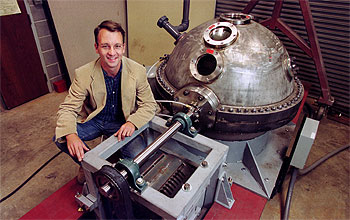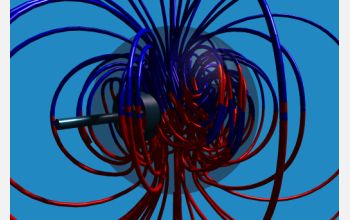All Images
News Release 05-001
The Dynamo in the Cornfield
To understand our planet's magnetic field, Wisconsin scientists are studying a ball of molten metal
This material is available primarily for archival purposes. Telephone numbers or other contact information may be out of date; please see current contact information at media contacts.

University of Wisconsin physicist Cary Forest with a prototype of the Madison Dynamo Experiment. In the full experiment, the one-meter wide, stainless steel shell is filled with molten sodium metal. (The prototype used water.) The metal, in turn, is stirred by two motor-driven, opposing propellers so that its motions simulate the natural, magnetic field-generating dynamos inside the Earth's core.
Credit: Jeff Miller
Download the high-resolution JPG version of the image. (949 KB)
Use your mouse to right-click (Mac users may need to Ctrl-click) the link above and choose the option that will save the file or target to your computer.

A computer simulation of the magnetic field that scientists expect to form in the Madison Dynamo Experiment. As intended, the predicted magnetic field shows a striking resemblance to the Earth's. The transparent sphere in the center represents the experiment's model of our planet: a stainless steel vessel containing a ton of molten sodium metal. The shaft coming in from the left is one of two, which together turn the propellers that stir the sodium.
Credit: Adam Bayliss, University of Wisconsin, Madison
Download the high-resolution JPG version of the image. (54 KB)
Use your mouse to right-click (Mac users may need to Ctrl-click) the link above and choose the option that will save the file or target to your computer.

Erik Spence, a physics graduate student, and Roch Kendrick, a mechanical engineer for the department of physics, prepare the Madison Dynamo Experiment for action.
Credit: Jeff Miller
Download the high-resolution JPG version of the image. (934 KB)
Use your mouse to right-click (Mac users may need to Ctrl-click) the link above and choose the option that will save the file or target to your computer.


